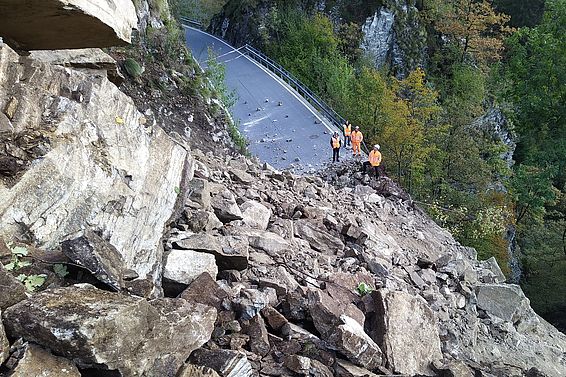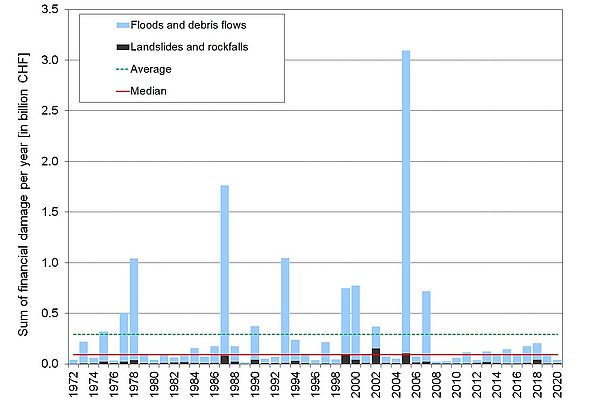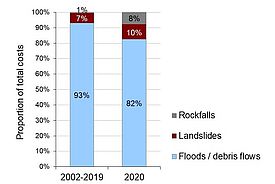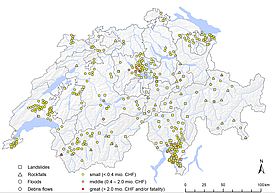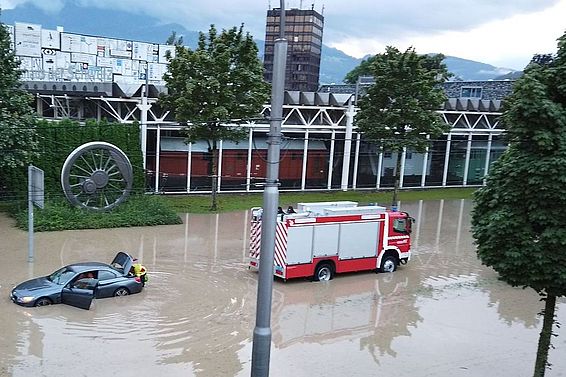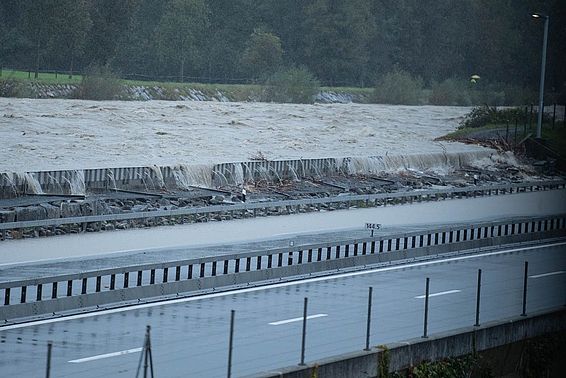In 2020, floods, landslides, debris flows and rockfall caused some CHF 40 million of damage in Switzerland. Most of the damage costs were the result of floods triggered by thunderstorms or persistent rain during the summer months. The Lucerne region and Ticino in particular were affected several times. These were the conclusions of the annual analysis of the Swiss flood and landslide damage database kept by the Federal Institute for Forest, Snow and Landscape Research (WSL).
In the 49-year data series, 2020 ranks among the ten years with the least damage from floods, debris flows, landslides and rockfall. Floods, overland flow and debris flows accounted for 82% of the damage, which totalled just under CHF 40 million. There was comparatively little damage from landslides (10%) and rockfall (8%). However, their share in the total damage last year was above average. Most of the damage occurred in June, July, August and October. There were two main reasons for the relatively low damage costs: on the one hand, there was less weather-related damage due to the long periods of dry weather; on the other hand, technical and organisational measures to curb natural hazards prevented or at least minimised damage.
Around half of damage on six days
Just over half of the total damage occurred in the cantons of Ticino and Lucerne on only six days. Two events caused considerable damage in Ticino. On 7 June, thunderstorms led to flooded cellars and streets, mainly in the Lugano District. The heavy rainfall in Ticino and neighbouring areas of the canton of Grisons on 28 and 29 August had much a greater impact, triggering floods, landslides and rockfalls. Several houses had to be evacuated in Bissone and Gambarogno. There were interruptions and obstructions to road and rail traffic in many places, and dozens of people were cut off from the outside world.
In the Lucerne area, the violent thunderstorms on 26 June and 1–2 July caused major damage, mostly as a result of flooding due to overland flow. Rainwater inundated cellars, underground garages and underpasses. In the city of Lucerne, homes in an apartment building in the Würzenbach district were devastated when the Gerlisbergbach stream overflowed, and traffic was interrupted due to flooded streets. The damage was also considerable in Ruswil, where several streams burst their banks.
Protective measures paying off
In early October, storm low Brigitte brought record rainfall over Switzerland. However, considering the huge quantities of precipitation, the damage was limited. This was largely due to the success of natural-hazard protection measures and the timely preparation of the emergency services. For example, the A2 motorway in the canton of Uri was closed and the flooded River Reuss between Attinghausen and Flüelen was diverted onto the carriageway via a relief channel. This saved the region from large-scale flooding. In Diesbach and Bettschwanden (canton of Glarus), the rapid action of the fire brigade prevented the bedload volumes transported by the flooded Diesbach stream from surging through the villages. In Locarno, too, preparations were made and the area near the lake was evacuated the day before the floods.
One fatality
Despite all the protective measures, not every accident can be prevented. In Finhaut (canton of Valais), a person was killed when their car was hit by a rockfall in October. This was the only death caused by the processes recorded in 2020.
The Swiss Federal Institute for Forest, Snow and Landscape Research (WSL) has been systematically collecting information on storm damage since 1972. The database created with significant support from the Federal Office for the Environment (FOEN) contains data on damage caused by floods, debris flows and landslides and, since 2002, rockfall, rock slides and rock avalanches. Damage caused by avalanches, snow pressure, earthquakes, lightning strikes, hail and gales is not taken into account. Estimates of property, infrastructure, forest and agricultural damage are based primarily on media reports. The data are available to experts upon request and constitute an important basis for risk assessment.
Contact
Links
Download PDF
- Article "Flood and landslide damage in Switzerland in 2020" for the magazine "Wasser Energie Luft" (Water Energy Air) (in German)
Copyright
WSL and SLF provide the artwork for imaging of press articles relating to this media release for free. Transferring and saving the images in image databases and saving of images by third parties is not allowed.

